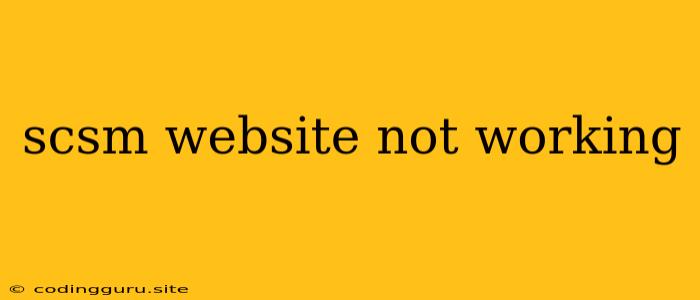Why Is My SCSM Website Not Working? Troubleshooting Tips for a Smooth Experience
If you're facing a situation where your System Center Service Manager (SCSM) website isn't cooperating, it can be frustrating. It's a crucial tool for managing your IT infrastructure, and downtime can impact your entire operation. Don't worry; this guide will equip you with the knowledge to diagnose and resolve common issues that might be preventing your SCSM website from working as intended.
Understanding the Problem:
Before we dive into the troubleshooting steps, it's essential to clarify the nature of the problem. Are you encountering:
- A blank page: This could indicate server connectivity issues, database problems, or script errors.
- Error messages: These are valuable clues. Pay close attention to the specific message displayed. It might offer insights into the cause of the malfunction.
- Slow loading times: This could be a sign of resource constraints, network bottlenecks, or inefficient server configurations.
- Partial functionality: Maybe some features work, while others don't. This narrows down the issue to a specific area of your SCSM website.
Common Causes of SCSM Website Issues
Several factors could be behind your SCSM website woes. Here are some of the most likely culprits:
1. Server Connectivity:
- Network Issues: Start by checking if your network connection is stable. Ensure that your server, clients, and the SCSM database can communicate seamlessly.
- Firewall Blockage: Firewall rules can sometimes block access to the SCSM website. Review your firewall settings, particularly on the server and client machines, to ensure they're not impeding communication.
- Service Availability: Make sure the required SCSM services are running properly. Check the status of services like the "SCSM Management Service" and "SCSM Web Service" through the Windows Service Manager.
2. Database Problems:
- Connectivity: Ensure your SCSM database is accessible. Verify that the database server is up and running, and that your SCSM configuration is pointing to the correct database instance.
- Database Errors: Look for any database errors in the event logs. These errors could indicate corrupted data, insufficient permissions, or underlying database issues.
- Database Size: A large database can lead to performance problems. Consider optimizing your database, potentially through indexing or partitioning, to improve efficiency.
3. Configuration Issues:
- Incorrect Settings: Double-check the SCSM website configuration, including URLs, port numbers, and database connection details. Ensure these settings are accurate and consistent.
- Permissions: Make sure your user accounts have the appropriate permissions to access the SCSM website and its underlying data.
- Server Configuration: Review your server's settings, including IIS configuration, security policies, and resource allocation, to ensure they're optimal for running SCSM.
4. Scripting and Code Errors:
- Javascript Errors: Examine the browser's developer console for JavaScript errors. These can often point to issues with your SCSM website's functionality.
- Server-Side Errors: Look for error messages in your server logs. These logs can provide valuable clues about the root cause of the problem.
- Code Updates: If you've recently made changes to your SCSM configuration or code, the problem might stem from a conflict or an unintended consequence of these updates.
Troubleshooting Steps
Here's a step-by-step approach to resolve your SCSM website issues:
-
Check for Server Availability:
- Ping the server.
- Check the server's status through the Windows Task Manager or other monitoring tools.
-
Verify Network Connectivity:
- Test network connectivity between the server and clients.
- Check for any network outages or firewalls that might be blocking access.
-
Investigate Database Issues:
- Ensure the database server is running and accessible.
- Check for database errors in the event logs.
- Verify the connection string in your SCSM configuration.
-
Review Configuration Settings:
- Double-check URLs, port numbers, and other configuration settings.
- Ensure user permissions are set correctly.
-
Examine Logs for Errors:
- Review IIS logs, Event Viewer logs, and database logs for error messages.
- Pay attention to error codes and timestamps to pinpoint the problem's source.
-
Consider Code Changes:
- If you've recently made changes to your SCSM code, revert them to rule out any conflicts.
- Check for any JavaScript errors in the browser developer console.
Tips for a Smooth SCSM Experience
- Regular Maintenance: Scheduled backups, updates, and security scans are crucial for preventing downtime.
- Monitoring: Implement monitoring tools to proactively detect performance issues or service failures.
- Documentation: Maintain clear and detailed documentation of your SCSM configuration, including server settings, database connections, and code changes.
Conclusion:
Troubleshooting SCSM website issues can be a methodical process. By following these steps and paying attention to the error messages and log files, you can effectively identify and resolve the underlying cause of your problem. Remember to prioritize server connectivity, database integrity, and configuration correctness to ensure a smooth and reliable SCSM experience.
